Art & Exhibitions
‘Picasso Sculpture’ at MoMA Is a Rock-Solid Winner
The modernist titan may be more influential in three dimensions than in two.

Image: Ben Davis
The modernist titan may be more influential in three dimensions than in two.

Ben Davis

“Picasso Sculpture” at the Museum of Modern Art is a show of riches, full of evidence of Picasso’s sprawling creativity. But the first thing that drew me up short was something tiny, almost a footnote: The Venus of Gas (1945).
The rusty, vaguely anthropomorphic shape beams at you like a totem reclaimed from some alien civilization, full of plangent weirdness.
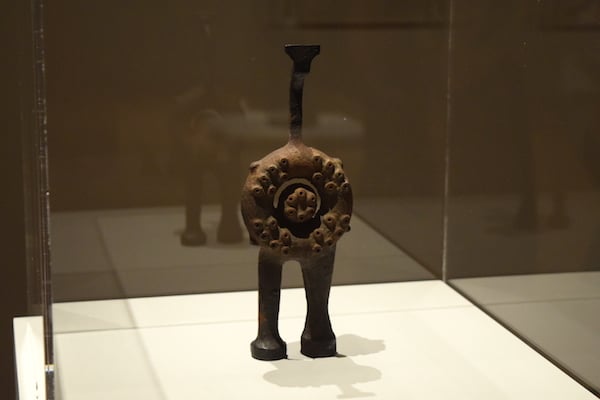
Pablo Picasso, The Venus of Gas (1945)
Image: Ben Davis
It also may be the closest that Pablo Picasso ever got to a true “readymade” of the Duchampian variety. It is little more than a stove burner turned on its end to unleash its totemic associations.
Picasso’s engagement with sculpture was, as curators Ann Temkin and Anne Umland write in the catalogue, episodic. He would dabble in three dimensions, go back to painting for years at a time, then return to a totally new type of sculpture: wire constructions in the 1930s, ceramics in the 40s, sheet metal follies in the 50s.
“Picasso Sculpture,” which opens to the public September 14, doesn’t try to make one story out of this; it just tries to keep up. The result is a lovely, zigzagging journey full of greatest hits and surprises.
It looks remarkably fresh for a show dedicated to one of the world’s most well-known artists. The Metropolitan Museum’s “Cubism” show this past year was similarly stacked with undeniable treasures, but felt to me deadeningly genteel. This show feels more lively and present. I think there is an interesting reason for that.

Pablo Picasso, Head of a Woman (1941)
Image: Ben Davis
The artistic world that Picasso came up in, in provincial Spain and cosmopolitan Paris alike, was one that was incalculably more rule-bound than the one we know today. His dealer, Daniel-Henry Kahnweiler, is said to have introduced to Picasso the then-novel concept that he might be a “painter-sculptor.” The two disciplines were walled off from one another by different craft traditions, with sculptors requiring training in specific media, like clay and bronze, that Picasso did not have.
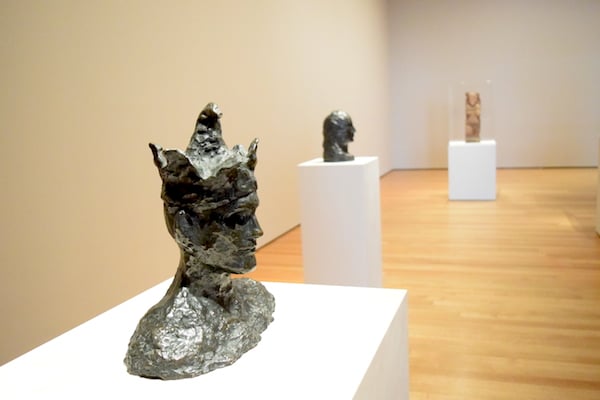
Pablo Picasso, The Jester (1905)
Image: Ben Davis
The earliest works featured at MoMA, coincident with his early Blue (1901-1904) and Rose (1904-1906) Periods, look quite conventional today because they still struggle to prove themselves before this tradition. The Jester (1905) is a refugee from the Rose Period’s traveling circus, charming but relatively inert, rendered in a sentimentally rugged style.
Then Cubism kicks in. By 1912, Cubist slicing and dicing of subject matter had yielded up the idea of incorporating scraps of found materials onto the canvas surface: newspapers, fake chair caning, and so on. In sculpture, Cubism’s pulverization of the conventions of depicting space proved less significant than its pulverization of conventions of what kind of media you could use. Suddenly, Picasso had license to play with non-art materials.
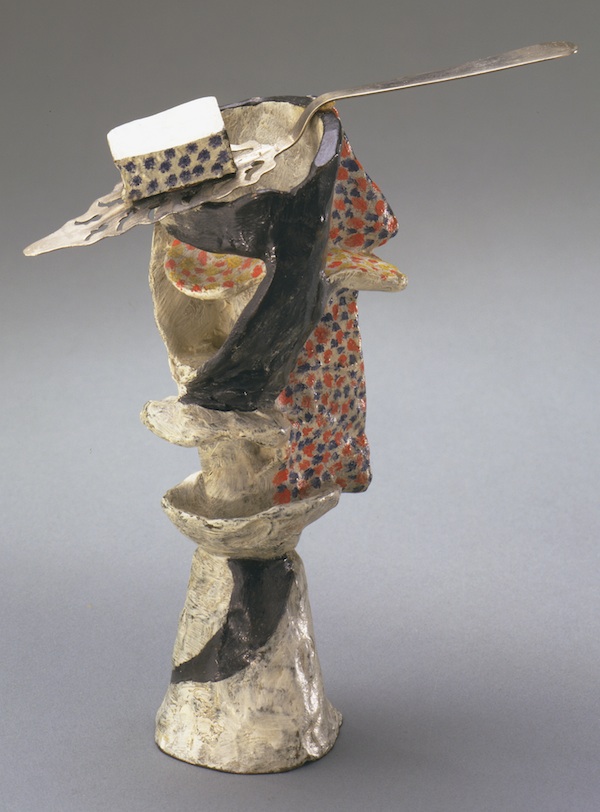
Pablo Picasso, Glass of Absinthe (1914).
Image: Museum of Modern Art © 2015 Estate of Pablo Picasso / Artists Rights Society (ARS).
His Glass of Absinthe, an edition of six bronzes from 1914 (in a curatorial feat, they’re all gathered together for this show), exemplify the evolution. They are jagged little trophies, fractured renderings of the bohemian libation. Each is given a flourish of uniqueness with some surface painting, but is alike affixed with an actual absinthe spoon supporting a metal sugar cube. Assemblage had arrived in sculpture.
Amid Picasso’s constant reinventions, the implication of this invention took a while to work its way through the system. The most famous of all Picasso’s found-object works hails from several decades later, in 1942. Laboring amid the relative privation of occupied Paris, he grafted a bicycle seat to a set of handlebars, a mythic bull’s head conjured from the detritus of urban life like the face of Jesus radiating from the Shroud of Turin.

Pablo Picasso, Bull’s Head (1942).
Image: Ben Davis.
Bull’s Head was cast in bronze, and what Picasso had to say about that decision is interesting:
The marvelous thing about bronze is that it can give the most heterogeneous objects such unity that it’s sometimes difficult to identify the elements that compose it. But that’s also a danger: if you were to see only the bull’s head and not the bicycle seat and handlebars that form it, the sculpture would lose some of its impact.
With this quote, Picasso seems to stand at a crossroads between different ways of thinking about art. His sculptures vibrate with the energy of transmissions picked up from everyday material culture, but he is still committed to the ennobling virtues of traditional materials, afraid that these everyday materials won’t add up to much on their own.
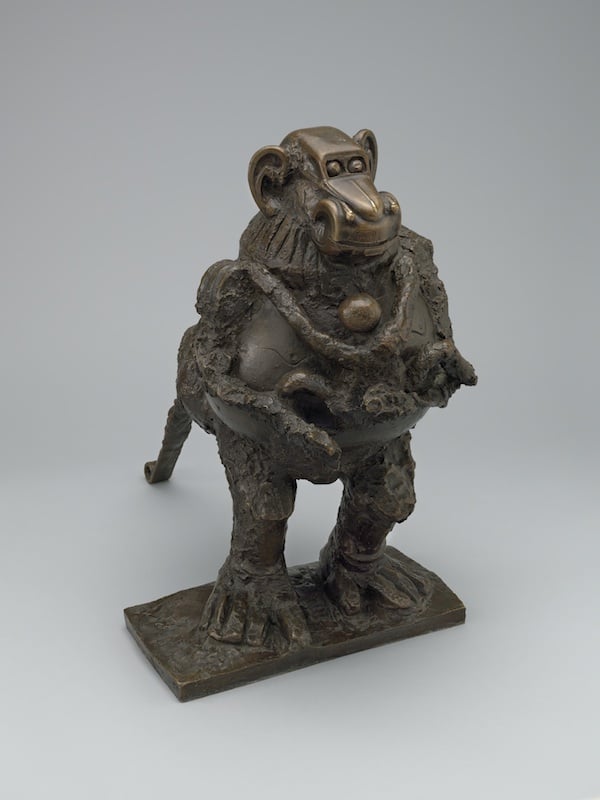
Pablo Picasso, Baboon and Young (1951).
Image: Courtesy Museum of Modern Art, © 2015 Estate of Pablo Picasso / Artists Rights Society.
A lot of their character comes from this tension. He doesn’t usually go as far as The Venus of Gas or Bull’s Head, but the popular touch spills through everywhere, as in Baboon and Young (1951), a remarkably charming creature whose facial expression is formed—when you inspect it—from the body of a toy car.
Picasso aged much better in sculpture than he did in paint. As a painter, by the late 50s he was engaged in the task of obsessively repainting the Spanish baroque masterpiece, Las Meninas. These paintings are rather boring pastiches of Diego Velázquez—not to mention his own synthetic Cubism. They look backwards to the Great Tradition to steal a bit of gravitas.

Pablo Picasso, Head (1958).
Image: Ben Davis.
Maybe it’s just good curating, but the late sculptures here feel much less enervated. A work like Head—made the year after the Las Meninas series, 1958—conjures a staring face with a wooden box, a board, and a couple of buttons. It retains a wily, untapped magic. Even the relatively cutesy painted wooden Bird (1958), which feels like a toss off, makes charming use of forks for feet.
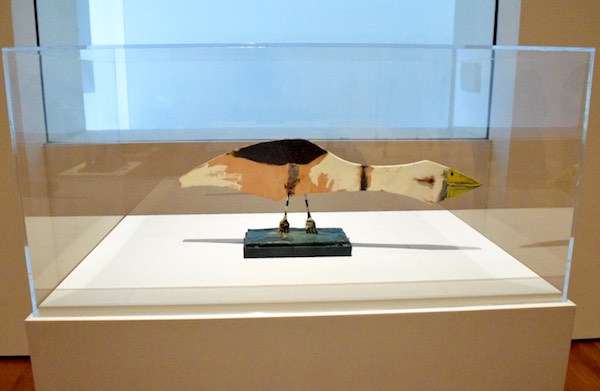
Pablo Picasso, Bird (1958).
Image: Ben Davis.
As an artist, Picasso will always be associated with painting, and specifically with Cubism, the ur modernist -ism. Yet for all its transformative power, the specific theories of Cubist painting were dated for artists working a generation later, a mode consigned to a previous era of development.
Assemblage, on the other hand, was one of the main events of the century to come. It represented the conceptual innovation necessary for visual artists to adapt to a world of mass-produced industrial objects and ever-more intensive media images. And so, in the light of history, Picasso’s sculpture ends up looking like it has more depth.
“Picasso Sculpture” is on view at the Museum of Modern Art from September 14, 2015–February 7, 2016.
Related stories:
Record Picasso Is a Bigger Deal Than You Think
Sotheby’s Sells Out Picasso Ceramics Collection
$27 Million Picasso Seized in Corsica